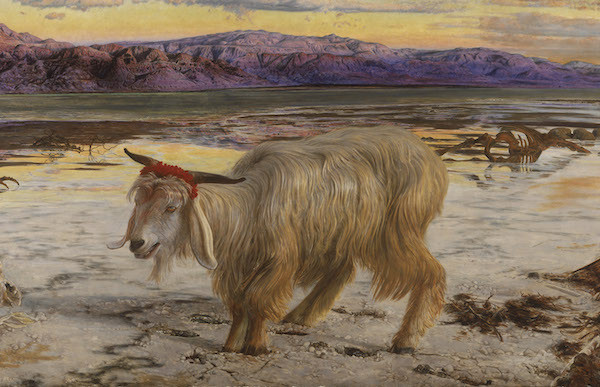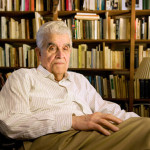Sacrifice and the Sacred
by Matthew Becklo
Filed under Jesus
I once saw a startling exhibition in the National Museum of Ireland in Dublin titled “Kingship and Sacrifice.” On display were two “bog bodies” – “Clonycavan Man” and “Old Croghan Man” – which, because of the chemical composition of the bogs in Ireland, were preserved in fairly recognizable shape for over 2300 years. Scientists and historians were able to extract a surprising amount of information from these bodies. The Irish Examiner explains:
"Both men had been subjected to gruesome deaths, indicating ritual killings. Old Croghan Man had holes cut in his upper arms through which a rope of hazel withies was threaded in order to restrain him. He was then stabbed and he had his nipples sliced, before finally being cut in half.
Clonycavan Man had been disembowelled and struck three times across the head with an axe and once across the body. This brutality is not confined to Irish bog bodies and has been paralleled on human remains from British and continental bogs.
Kelly believes that both men were failed kings or failed candidates for kingship who were killed and placed in bogs that formed important tribal boundaries. Cutting the nipples was more than simply a brutal act. Its purpose was to dethrone the king. “Sucking a king’s nipples was a gesture of submission in ancient Ireland,” says Kelly. “Cutting them would have made him incapable of kingship in this world or the next.”
There was obviously plenty to be disturbed about here. But looking down and seeing the two leathery bodies, their violent end sealed on them forever, was the most disturbing thing of all. This brutal Celtic past was not a hypothetical or even an abstraction – it was ossified flesh in a glass case beneath me.
In How the Irish Saved Civilization, Thomas Cahill reminds us that this behavior was not confined to the ancient Celts, and that nearly all early peoples sacrificed human beings. At a certain point, human sacrifice becomes “unthinkable,” and is substituted with animal sacrifice – but blood sacrifice remains, and almost always as part of a religious ritual. Why?
Our anachronistic impulse is to see the latter as causing the former. Religion thirsts for victims to appease a fearsome deity, and sacrifice satiates it. What could be clearer? But we “delude ourselves,” Cahill argues, if we reduce the “complex history of religious feeling” to this caricature. In reality, sacrifice and the sacred – linked though they are – are both functions of a deeper cycle of victimization written into the very heart of social order.
Anthropologist and Catholic convert René Girard has spent a lifetime trying to better understand this cycle. According to Girard, ancient human societies were destabilized by mimetic conflicts: two parties who desired the same object would start to imitate each other’s desire until the rivalry erupted into a kind of contagion which threatened to destroy the whole community. Then, a hidden mechanism was triggered which transferred the blame onto a third party, one that was either uniquely strong (e.g., a mighty king) or uniquely feeble (e.g., a decrepit itinerant). The collective sacrifice and sacralization of this figure, enshrined in religion, was a sort of release valve that restored peace and order in the community. Girard termed this third party “the scapegoat” after a rite of atonement in ancient Judaism in which the “transgressions of the Israelites” were transferred to a goat and driven out into the wilderness (Lev. 16: 21-22).
The explanatory power of Girard’s theory is immense: the ritualized sacrifice, collective persecution, and mythical traditions of the ancient world are all best explained by one and the same scapegoat mechanism.
But it doesn’t end there. The theory also clearly has something to do with Christianity and our “Holy Week”. But what exactly?
Anthropologist James Frazer saw in Christianity one more mythical story of death and rebirth. On this reading, Christianity is modeled after scapegoating only insofar as it's modeled after other mythical situations. But for Girard, this misses the obvious point of departure: that Christ is declared an innocent victim. The scapegoat mechanism doesn’t see innocent victims; it doesn’t see victims at all. It only sees that guilty outsider, that “true” threat that has to be eliminated.
But the New Testament, building on the groundwork of the Old, exalts victims of collective violence through a supreme, innocent Victim. There’s an irony in this: the summit of scapegoating violence unexpectedly collapses on itself through itself. As Girard puts it: “God Himself reuses the scapegoat mechanism, at his own expense, in order to subvert it.” (An early metaphor for Christ – that of a mother pelican gnawing at her own breast to feed her starving young – captures this idea perfectly.) The Christian sacrifice is an inversion of all sacrifice, one which tilts the scales back against the community by mirroring its violence back at itself.
The same is true of the Mass. The ancient world was so immersed in ritual violence that the Mass was, in the second century, suspected of being a cannibalistic cult which consumed the flesh and blood of its members. The reality, of course, was far less strange – there was only ordinary bread and wine – but talk of sacrifice, and of consuming of the body and blood of a victim, remained. In the Mass, as in Good Friday, reflections of the outward forms of scapegoating are present, but only to redound upon the head of the community. The whole interior logic had become one of self-sacrifice – and Christ’s love, not man’s violence, had become the means of restoration.
In Ireland – as in so many countries still immersed in human sacrifice – this mighty itinerant, decrepit king, and “Lamb” of God transitioned the people from ritual violence to collective disarmament. Cahill explains:
“Patrick declared that such sacrifices were no longer needed. Christ had died once for all...Yes, the Irish would have said, here is a story that answers our deepest needs – and answers them in a way so good that we could never even have dared dream of it. We can put away our knives and abandon our altars. These are no longer required. The God of the Three Faces has given us his own Son, and we are washed clean in the blood of this lamb. God does not hate us; he loves us. Greater love than this no man has than that he should lay down his life for his friends. That is what God's Word, made flesh, did for us. From now on, we are all sacrifices –but without the shedding of blood. It is our lives, not our deaths, that this God wants.”
The song “There Is a Valley” by Bill Fay captures this historical transformation in a few powerful verses filled with pathos:
There is a valley where the trees stand tall and an icy wind blows
Trees don't speak, but they speak to each other of a people long ago
When the soldiers came and took away the villages one by one
And the fury of that moment they felt, but could only silently look upon
There is a mountainside where sheep are grazing with their young
Sheep don't speak, but they speak to each other of a killing long ago
When the people came and sacrificed their children to the sun
And the fury of that moment they felt, but could only silently look upon
There is a hill near Jerusalem that wild flowers grow upon
Flowers don't speak, but they speak to each other of a crucifixion
Guess because he said he was the son of God
And the fury of that moment they felt, but could only silently look upon
Every city bar brawl, every fist fight, every bullet from a gun
Is written upon the palms of the Holy One.
This anthropological perspective on Christ's death is indispensable; it gives proper context, for example, to the film The Passion of the Christ. As one journalist notes, the film’s apparent fixation on violence makes perfect sense through a Girardian lens. “The blood and gore of the supreme sacrifice is not a distraction from the Christian message,” he writes. “It is the message itself.”
Even if we accept this, we’re still faced with the difficulty Girard poses in his most recent book: “Why is there so much violence in our midst?” Cahill argues that “cut flowers, Christmas trees, vigil lights, and the Mass may be the last vestiges” of sacrifice. Nothing could be further from the truth. The twentieth century has been called “the bloodiest century in modern history.” A bombardment of headlines about mass beheadings, mass shootings, and mass nuclear threats – not to mention domestic violence, school violence, and gang violence – portend more bloodshed in our own. Why, if the above is all true, is the world still so violent?
Girard argues that even though ritualized violence has largely collapsed, scapegoating continues to play out “at the level of individuals and communities.” Without access to their original structure, these violent impulses (whether they play out physically or not) become more sporadic and random, and occur “in a shameful, furtive, and clandestine manner.” We all see oppressors everywhere (a religion, a political party, a neighbor, a family member), but we don’t see ourselves as being involved in the same nexus in our own way. Scapegoating, paradoxically, is “universal as an objective experience, and exceptional as a subjective experience…It would appear that everyone participates in this phenomenon, except each one of us.” Put another way: “to have a scapegoat is to believe one doesn’t have any.”
To tear up scapegoating up at its roots, we have to confront the full picture Christ’s saving action existentially. In Girard’s view, “knowing the emissary victim requires a certain kind of conversion, namely, that one has to come to see oneself as a persecutor.” We deny this up and down, of course. Why can’t we just apply Jesus’ moral message (a more palatable version, anyway) and stop short of faith? We can, and we do; but still, we feel increasingly helpless to shake the curse of our own habitual violence. For Girard, this is no coincidence.
The 1999 documentary Messiah pairs Handel’s oratorio with the less attractive features of modern life, including its spasmodic brutality. In it, one sequence leads us to the victorious “Hallelujah” by way of some disturbing footage of mob violence (warning: graphic). We’ve all heard this “Hallelujah” song before, usually as capturing some moment of superficial joy in a movie or commercial. But here, it reclaims its original meaning though this Girardian prologue. The bass soloist, who seems to laugh at the insanity of it all, wonders why people rage against each other the way they do. The tenor announces the breaking of this endless cycle of persecutors and victims “like a potter’s vessel.” Then the chorus of Easter emerges again with new power: the humbling of every kingship, the subversion of every sacrifice, and the freeing of every scapegoat – all except for One.
Related Posts
Note: Our goal is to cultivate serious and respectful dialogue. While it's OK to disagree—even encouraged!—any snarky, offensive, or off-topic comments will be deleted. Before commenting please read the Commenting Rules and Tips. If you're having trouble commenting, read the Commenting Instructions.













